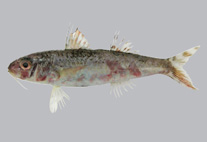Abstract
Upeneus lombok n. sp. is described from two specimens collected off Lombok, Indonesia, at depths of 54–76 m, and one subadult specimen from the local fish market at Tanjung Luar, Lombok. Four specimens of U. asymmetricus were collected at the same fish market representing the first record of the species since its description from two Philippine Islands in 1954. These two species are compared in detail and with five congeneric species that all share a 7-spined dorsal fin and a high gill-raker count. Upeneus lombok n. sp. differs from all other congeners in having a short snout (snout length 9.0–9.6% SL) combined with a low anal fin (anal-fin height 12–13% SL in adults, 15% in single subadult). The newly recorded U. asymmetricus specimens differ from their types only slightly and all eight specimens together differ from all congeneric species in the combination of 7 dorsal spines, 12–14 pectoral fin rays, 26–28 total gill rakers, short pectoral fins (pectoral-fin length 18–21% SL) and short jaws (upper jaw length 8.7–11% SL). In both species the caudal-fin colour patterns of fresh fish are of diagnostic significance, the only exception being a close similarity between Upeneus lombok n.sp., U. saiab, and U. seychellensis. Additional comparisons with 14 Upeneus species which overlap in distribution or occur in nearby areas are also made. Needs for further taxonomic exploration of the Indonesian-Philippine region and for enhanced attention to the economic and ecological importance of Upeneus species are discussed.

